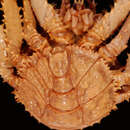en
names in breadcrumbs


“Paralomis birsteini sp. n. (Figs. 4, 5a-e)
Paralomis spectabilis; Birstein & Vinogradov 1967, p.390, figs. 1,2 (not Hansen 1908).
Holotype. USNM 228830, ♀; LC = 55mm; MW = 53mm. USARP, Eltanin Cruise 27, Sta. 1946, 2 Feb 1967, 67°29'S, 179°55'W, 1080m.
Paratypes. ZMUM 2518, 2 ♂ ♂; LC= 67, 68mm; MW = 67, 74mm; 3 ♂ ♂ (broken). R/S Ob, Sta. 377, 1 Apr. 1958, 67°23'S, 179°53'W, 500-900m.
Description
Carapace somewhat pentagonal in its contour, as long as broad, dorsal surface covered with granules of small size and several spines. Gastric region convex, more prominent than other areas. One unpaired spine in front of central portion, 3 pairs of shorter spines out towards lateral margins. Cardiac region, separated from gastric one by deep transverse furrow, with 2 pairs of small spines. Branchial region with 1 small spine near cervical groove, 1, more acute, in center of area, and 2 near postero-lateral angle.
Rostrum terminating in 1 median inferior and 2 lateral superior spines, surpassing end of eyes. Median lower spine weakly curved upward, without granules on its ventral side; dorsal pair more curved and directly obliquely upward.
Post-ocular spine small, not surpassing end of eyes. First antero-lateral spine strong. Carapace margins with 5-6 spines of different sizes on anterior half and 4 on postero-lateral angle. Some small spines on posterior margin.
Eye stalks with several dorsal granules near cornea. First segment of antennal peduncle with 1 small spine on outer border. Second segment with 1 strong spine and 1 small tubercle on outer margin. Acicle with single strong terminal spine, not surpassing end of antennal peduncle. One or two smaller spines on outer margin and 1-2 very small spinules on inner side.
Chelipeds subequal in length, right stouter than left. Merus and carpus armed with several spines, stronger on dorsal margin. Hands with small spines on dorsal edge. Several granules on surface of articles. Tufts of hairs on fingers.
Walking legs long, slender and depressed. Third leg more than 2 times length of carapace, shorter than first and second. Merus of third leg 1.7 times as long as carpus and 4-5 times as long as broad. About 10-12 distinct spines present on anterior margin, 6-8 smaller on posterior edge. Carpus only with a row of spines (9-10) on anterior margin. Propodus usually 5 times as long as broad and 0.8 times length of merus, with 9-11 spines on anterior border and 6-7 on posterior one. Several spines on dorsal surface of merus, carpus and propodus, being smaller on last article. Ventral margins smooth. Dactylus longer than propodus, with small spines on proximal portion and a row of 12-15 spinules on posterior margin.
Abdominal segments covered with granules of different sizes. Small spines on external edges of second segment. One small dimple on either side of median line. Marginal plates of segments 3-5 not subdivided, not fused with lateral ones.
Etymology.
This species is dedicated in homage to Dr Y. A. Birstein from the Department of Invertebrate Zoology of the State University of Moscow, for his important contributions to the knowledge of the Lithodidae.
Remarks
Among the known species of the genus, P. spectabilis Hansen, 1908 (North Atlantic) is the closest kin of the new species. P. spectabilis is, however, distinguished from P. birsteini in the following ways.
In P. spectabilis (1) the rostrum is slightly pedunculated, (2) the dactylus of the walking legs is shorter than the propodus and (3) the acicle has the inner border smooth (Figs. 5f—h). In contrast to these features, in P. birsteini (1) the rostrum is not pedunculated, (2) the ambulatory legs are much more slender and the dactylus is longer than the propodus and (3) the acicle has 1-2 small spines on the inner margin.”
(Macpherson, 1988)
Paralomis birsteini is a species of king crab.[1]
El centollón (Paralomis birsteini) es una especie de crustáceo decápodo que integra el género de cangrejos litódidos Paralomis. Habita el lecho marino de las frías aguas del océano Antártico y del sur de los océanos Atlántico e Índico.
Paralomis birsteini fue descrita originalmente en el año 1988 por el carcinólogo español Enrique Macpherson.[1] El ejemplar holotipo es una hembra de 55 mm de largo, catalogada como USNM 228830. Fue colectada el 2 de febrero de 1967 en las coordenadas: 67°29'S 179°55'W, a una profundidad de 1080 m. Este, y el otro ejemplar utilizado para describir la especie fueron depositados en el National Museum of Natural History (Smithsonian Institution, USNM) y en el Zoological Museum de la Universidad de Moscú (ZMUM).
Paralomis spectabilis Hansen, 1908 —un cangrejo del Atlántico Norte — es la especie más relacionada.
El nombre específico birsteini es un epónimo, derivado del apellido del profesor Dr. Yakov Avad'evitch Birstein, del Departamento de Zoología de Invertebrados de la Universidad Estatal de Moscú, como un homenaje por sus importantes contribuciones al conocimiento de los integrantes de la familia Lithodidae.
Habita en la plataforma continental del mar Argentino, en aguas situadas al este de las islas Malvinas[2] y en el océano Antártico en las islas Orcadas del Sur y en el mar de Bellingshausen,[3] en profundidades de hasta 1876 m.[4] También fue reportada para los archipiélagos subantárticos franceses de las islas Crozet y Kerguelen situados en la parte sur del océano Índico.[5]
El centollón (Paralomis birsteini) es una especie de crustáceo decápodo que integra el género de cangrejos litódidos Paralomis. Habita el lecho marino de las frías aguas del océano Antártico y del sur de los océanos Atlántico e Índico.
Paralomis birsteini is een tienpotigensoort uit de familie van de Lithodidae.[1] De wetenschappelijke naam van de soort is voor het eerst geldig gepubliceerd in 1988 door Macpherson.
Bronnen, noten en/of referenties